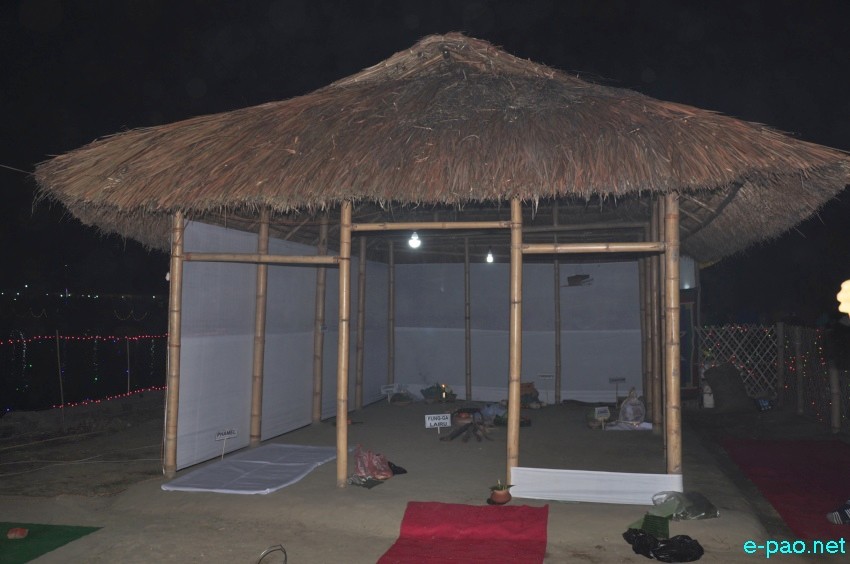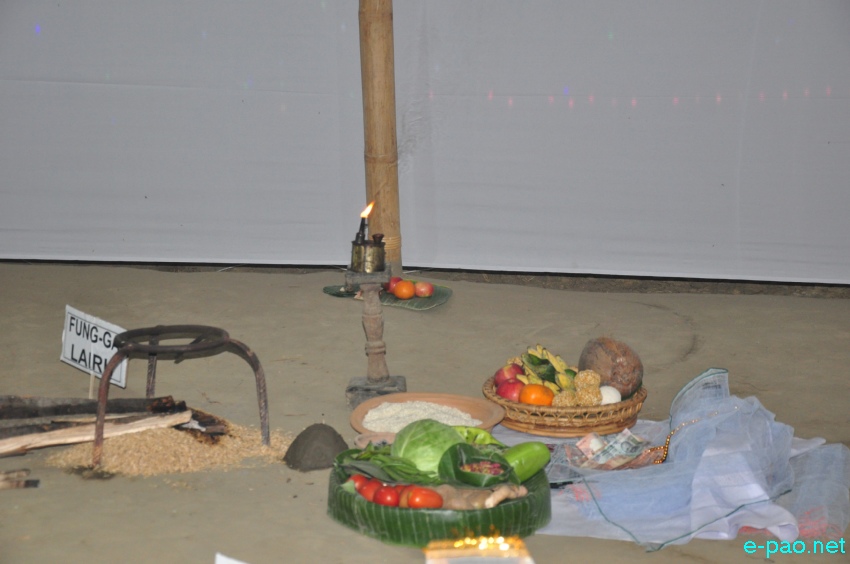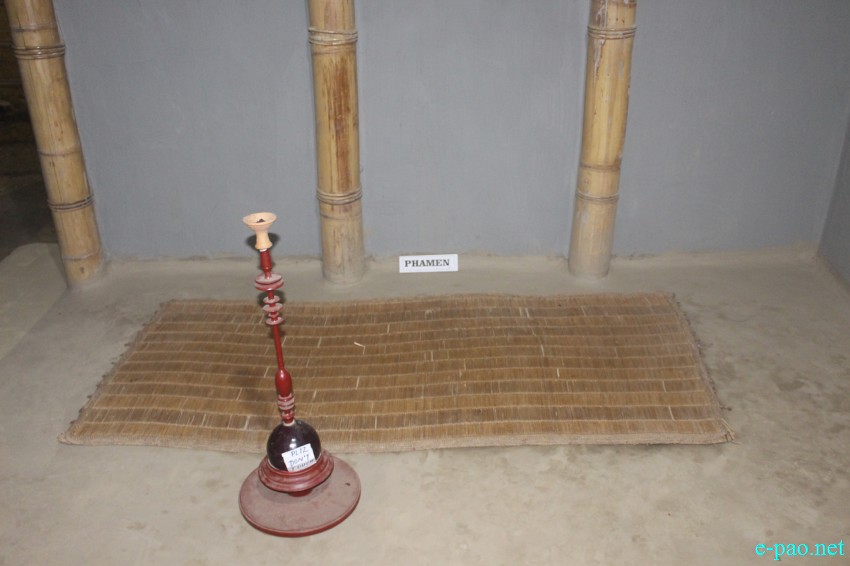My memories of Imphal from 1941
- Part 7 -
Dr Mohendra Irengbam *

Different aspects of Meetei Yumjao being displayed at Wangkhei Ningthem Pukhri Mapal in January 2016 :: Pix - Gnet
I have been writing this memoir, partly as a therapeutic tool in my doldrums from this pandemic. I have so far gathered my individual testimony albeit rather inconsistently, from those gleeful days that have worked their way into my present memory. Some are more desolate than in my recollections. My nostalgia only brings good memories, unpleasant ones are left behind knowing that, ‘Yesterday was history Tomorrow is mystery and today is living’.
I have resorted however, to one of the fundamental technical devices of historical writing–‘periodisation’, as much as I could. So, the period of Johnstone School in the old building remains forever as a candle on the cake for me.
It gave me a leap of faith in a bright future. Its location in the Khwairamband Bazaar was like a humble landmark for Imphal as Trafalgar Square is for London, and Times Square for New York. In front of it and across by the main Road there was a row of wooden cubicles, back to back, arranged from west to east, beginning from the Sadar Bazaar Street to the access road for the Polo ground pavilion.
They were called Nupa Dukan (Men’s shop). They sold ready-made clothes, vests, leather and canvas shoes, socks and other items to wear. Large Marwari buildings lined both sides of the Sadar Bazaar Street. They extended southwards from the main central road upto the Sahib Manai settlement by the eastern bank of the Nambul River.
The buildings on the east side of the street was interposed by two cinema Halls, and in the west by one cinema hall. On the eastern side and behind the British Residence, the space was vacant right upto the Keishampat junction. In the Sadar Bazaar, between the Marwari buildings on the west side of the street and the Nambul River, there was another small bazaar that had stalls similar to the ones in the Ima market. All sorts of goods were sold there.
Khwairamband Keithel was not just a market but a meeting place, a relaxing venue, for many people in the evening. The outer Polo Ground or the Mapal Kangjeibung was like a park. By dusk, laissez faire Meitei men, dressed in pristine white dhotis and shirts, and wrapped up in woollen shawls in winter, would traipse along to the Mapal Kangjeibung for leipung famba (gathering for idle talk) to indulge in waremngangba (idle talk) to kill their time, while their wives at home prepared dinner.
On Sunday afternoons in winter, Mapal Kangjeibung provided entertainment to the men folks with polo games. The matches were between two Meitei panas (arbitrary districts of Manipur) of which there were four in number: Naharup, Ahallup, Khabam and Laipham.

Different aspects of Meetei Yumjao being displayed at Wangkhei Ningthem Pukhri Mapal in January 2016 :: Pix - Gnet
There were 1 or 2 sahibs on each side, wearing breeches and knee-high boots and donning solar hats. The pavilion was always full with other sahibs and Meitei elite. Sometimes, Memsahibs and their children were present. My father was often a guest there.
The Thakurbari buildings on the east side of the Sadar Bazaar were separated from the Polo Ground by an avenue that stretched from the main road and behind the pavilion, to the footpath just outside the northern chicken wire fencing of the British residency. The pavilion was small.
It was closed at the back but open on all three sides except for 1 metre high wooden railings, which were interrupted in front to accommodate a few steps down to the ground, and another smaller one on the south side.
Opposite the Polo Ground on the north side and across the main road, there was the Civil Hospital with 80 beds (cf. 12 & 13). It had a British Civil Surgeon. I remember only one ward, where my second brother Yaima was once admitted with stomach ulcer. It had an outpatient department (OPD). I remember one compounder Manijao from our Uripok. He was the heart and soul of this department.
Just after the War, I sometimes went to the OPD to ask for potassium permanganate. I liked the purple colour it imparted in water. I also liked the smell of the OPD. There were two middle aged female nurses in white uniform and a white cap. One of them was called Kamini. The other escapes my mind. They were like film stars. There was an operating theatre in the middle of the hospital.
The Meitei men who thronged in the Khwairamband Bazaar, lived in dwelling houses, known as Yumjao, which was the pride of Meitei architecture. It was recorded, a bit like a blueprint, in Meitei alphabet, in Yumpham. Legend has it that Yumjao was introduced by a mythical king named Khooi Ningon, but in the reign of King Khagemba many changes took place.
A yumjao would be built with vernacular architecture by indigenous engineers after laying the foundation stone (Jatra Hunba) on an auspicious day. Most yumjaos had bamboo pillars or posts and were roofed with thatch grass. The rich had bigger yumjao with wood pillars, especially for the veranda.
They would last years. My father was a modern civil engineer, but he had to employ a native house builder to get his yumjao built. That lasted 100 years until it was demolished by a family member to construct a modern house. Only the replacement of the thatch grass once a while, in some parts, was all that was needed.
The Yumjao always faced east to get the morning sunshine and had a big front door with a window on each side. Usually most houses had no windows on the sides. At the back in the northern wall a door was always fitted called awangthong (north door) for access to and from the back. There were no partitions inside.

Phamen Part of a traditional house of Manipur displayed at Heritage Park at Hapta Kangjeibung in November 2018 :: Pix - Shreebas Laipubam
The kitchen was traditionally situated further back to the awangthong at the north-end corner without a chimney or window, which made the room a bit smoky. The oven was moulded with clay. Fire logs, or straw for the poor, were burned as fuel for cooking.
At the centre of the house there was a phunga, a small hearth, in which the paddy husks were slowly burned all day and night. A metal tripod was kept over it for heating water in a pot made of glazed earthenware or metal, and for heating the room in winter. The bed of the head of the family (usually the father) was placed in ‘Luplenkha’ in front and by the south wall. Mother’s bed was behind the father’s.
Children slept at various places close to the wall, leaving the central portion unoccupied. The beds might be screened with hanging mats.Traditionally, there was a big free-standing chest where family valuables were kept. At the southern back-end corner was an altar for the Meitei household God, Sanamahi, known as Lainingthou (king of the gods).
The Yumjao invariably, had a large open mangol (veranda) in front, as a lounge and for receiving guests. By custom, on the southern side of the mangol, a mat made of reeds was spread every morning for the head of the family, usually the father, to sit on cross-legged. Nobody was to intrude upon it.
The mat was usually thin but could be as thick as 10cm and expensive for the well-off. Usually a dry bamboo jar about 14cm tall was hung up on the front end of the southern wall of the house in which the home-made ‘toothbrushes’ were kept.
These toothbrushes (yathinpaya) were flat, thin sliced bamboo sticks; 150 x 5 x 2 mm. One end had to be chewed first to turn it into a fine brush. The long edge of the stick was used for scraping the tongue before rinsing the mouth with water from a metal jug that was laid out there by the womenfolk of the family early in the morning, before the head of the family got up.
Alloy bell-metal pots were used for cooking rice. Dinner plates (pukham), bowls (Tangot) for dishes, and drinking water jugs (Khujai) were also of bell-metal. Vegetables were cooked in glazed earthenware or terracotta pots (uyan), made by the ‘Loi’ people in far off villages. Wrought iron pans (khang) were used for frying.
A Yumjao was located in an Ingkhol (homestead or garden house). The word Ingkhol has no English equivalent. So, during the British Raj, it was registered as such. The Ingkhol had a shumang (courtyard) in front of the house, at the centre of which there was always a Tulsi plant - Indian basil, which is sacred to Hindus.
Every ingkhol was fenced on three sides with dry bamboos, which grew aplenty in the back of the Ingkhol on 3 or 4 feet high earth mounds. It had a gate made of two upright bamboo poles with 3 or 4 holes through which slimmer bamboo poles passed through, either to close or open the gate.
An average ingkhol had a rectangular barn-like building open on the west side, known as mamangshangoi (front barn). It was always built close to the eastern boundary. It was meant for holding social functions. It was also built with bamboo, mud walls and thatched roof. Some rich people with a bigger ingkhol, had another such barn on the north side, known as awangshangoi (north barn).
In these Ingkhols most families grew a variety of vegetables, such as cabbage, cauliflower, and definitely herbs, such as Maroinapakpi (Hooker Chives), maroinakuppi (Chinese Chives), nungshhidak (mints) and the like.
My father grew cabbages in our Ingkhol. In winter the caterpillars of the white butterflies crawled all over our mangol and I used to have an allergic itch from them.
If these ingkhols were large enough they would have small to medium-sized ponds, traditionally on the northern side of the Yumjao. It was customary to plant tall sanarei (marigold) plants near the gate and kaboklei (gardenia) by the ponds.
Sanarei plants were also grown by the temples whose gardens were always open. Chinichampa (Hari champa) shrubs with fabulous fragrance that had three greenish outer petals and three inner petals, were also planted by the ponds.
Leihao (Magnolia champaca) tree with very dewy orange-yellow flowers with unfurled petals, are favourites among the Meiteis. The combination of such a few musky flowers in a small bunch, ‘Lei nachom’ that women used to wear above their right ears, superseded all the expensive perfumes one can buy now in the market.
* Dr Mohendra Irengbam wrote this article for The Sangai Express
This article was webcasted on November 16 2020 .
* Comments posted by users in this discussion thread and other parts of this site are opinions of the individuals posting them (whose user ID is displayed alongside) and not the views of e-pao.net. We strongly recommend that users exercise responsibility, sensitivity and caution over language while writing your opinions which will be seen and read by other users. Please read a complete Guideline on using comments on this website.








